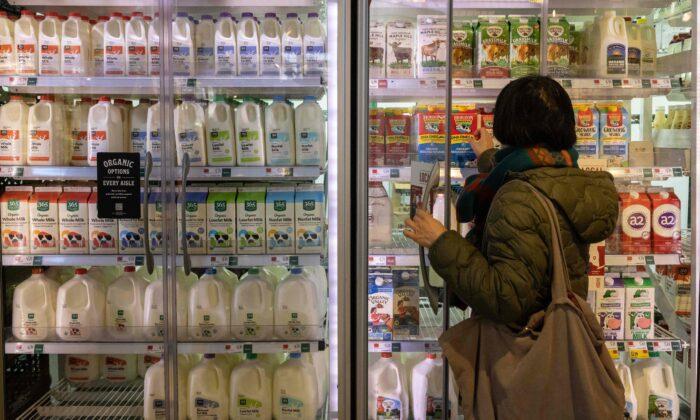However, the consumer price index (CPI) rose by 0.4 percent month-over-month, up from 0.1 percent in March. The huge jump in the monthly CPI was largely driven by increases in shelter costs, gasoline, and used vehicles.
The core inflation rate, which strips the volatile food and energy components, also dipped to 5.5 percent annually in April, down from 5.6 percent in March. This matched market expectations. However, the core CPI jumped by 0.4 percent from March to April, remaining steady from March.
On a year-over-year basis, the food index slowed to 7.7 percent, with supermarket prices coming in at 7.1 percent. The food away from home subindex rose by 8.6 percent compared with a year ago.
Within the food index, egg prices maintained their downward trend, sliding by 1.5 percent in April. But they’re still up by more than 21 percent year-over-year. Lettuce, which has also experienced meteoric gains in recent months, increased by 3.9 percent year-over-year and 3.5 percent month-over-month.
The energy index fell by 5.1 percent at an annualized rate but rose by 0.6 percent month-over-month.
Gasoline surged by 3 percent month-over-month, but it’s down by 12.2 percent from last year. Electricity costs fell by 0.7 percent in April but remain up by 8.4 percent year-over-year.
On a monthly basis, new vehicles tumbled by 0.2 percent, while used cars and trucks surged by 4.4 percent. Apparel rose by 0.3 percent. Medical care commodities jumped by 0.5 percent, while medical care services slid by 0.1 percent. Transportation services dropped by 0.2 percent.
Shelter, which economists argue is a lagging indicator, continues to be elevated, rising by 0.4 percent month-over-month. Rent of shelter is up by 8.2 percent year-over-year and swelled by 0.4 percent month-over-month. The owners’ equivalent rent of residences also advanced by 8.1 percent from a year ago and rose by 0.5 percent month-over-month.
“Given the six- to eight-month lag between when housing costs decline and when the Fed’s [Federal Reserve’s] inflation metrics reflect those changes, it’s very likely that housing costs will continue to come down,” said Bryce Doty, the senior vice president and senior portfolio manager at Sit Investment Associates.
The annual services inflation eased to 6.8 percent, the first time it has fallen below 7 percent since August 2022. Services inflation, which accounts for everything from medical services to child care and education, has been a sticky metric for policymakers.
The financial markets turned positive in pre-market trading following the better-than-feared CPI data.
The U.S. Dollar Index, a gauge of the greenback against a basket of currencies, fell by 0.15 percent to 101.45 following the news.
U.S. Treasury yields were red across the board, with the benchmark 10-year yield down by about 7 basis points to 3.45 percent.
“This inflation report confirms CPI is trending as expected,” said Giuseppe Sette, president of market analytics firm Toggle.
Despite investors cheering the news, Ryan Young, a senior economist at the Competitive Enterprise Institute, said he believes that the conditions don’t look so great when digging deeper into the data.
“Today’s core CPI numbers are especially troubling,” he said. “Volatile food and energy prices distort CPI readings by moving around for reasons having nothing to do with monetary inflation. Core CPI removes those numbers to get a clearer picture. April’s core CPI number is 5.5 percent over the last year, compared to 4.9 percent for the headline CPI number.”
Inflation Too High for the Fed
The chief talking point among officials at the U.S. central bank is that inflation is still too high.Speaking at the Economic Club of New York on May 9, New York Fed Bank President John Williams suggested that interest rates could be increased if price pressures don’t diminish.
In the first quarter, the gross domestic product growth rate was 1.1 percent, the lowest print since the second quarter of last year.
“This inflation report seems to suggest that for the time being, the Fed will not have a problem with inflationary pressures, which are trending as expected,” Sette said. “With core CPI firm at 5.5%, traders would do well to remember that rates historically are always higher than inflation except during a recession. In other words, rates don’t need to rise for monetary policy to be restrictive.”
Overall, according to Young, the U.S. economy is witnessing “the aftereffects of Washington’s pandemic spending overreaction.”
“Instead of sticking to pandemic-related aid, they grew the money supply by $5 trillion and passed every wish-list spending item they could. This caused today’s inflation as well as today’s debt-ceiling drama. An adult approach to COVID relief would have avoided all of these problems,” he said.
More inflation data will be released this week.
The April producer price index (PPI) will be published on May 11, which is expected to climb by 0.3 percent month-over-month but slow to 2.4 percent year-over-year. The core PPI is projected to rise by 0.2 percent month-over-month and dip to 3.3 percent on an annualized basis.
Import and export prices for April are anticipated to be little changed, according to consensus estimates.





